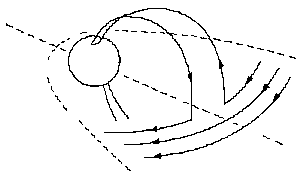 Substorm current wedge (SCW)
Substorm current wedge (SCW)
spaceweb@oulu.fi - last update: 4 January 1999, 0920 UT (RR)

Introduction
During a magnetospheric substorm the cross-tail
current is disrupted (e.g., Fairfield and Ness, 1970).
A current system called the substorm current wedge
(SCW; Atkinson, 1967; McPherron et al., 1973) is formed as
this current is diverted through a
circuit consisting of earthward (downward) field-aligned
currents (FACs) on the eastern side of the wedge, a westward
auroral electrojet in the ionosphere, and
tailward (upward) FACs on the western side of the wedge.
The current disruption leading to SCW formation is acting on
current sheet that has been enhanced
and/or propagated closer to Earth during the preceeding substorm growth phase
(Kaufmann, 1987).
The mechanism creating the disruption is still unknown (see, e.g., Lui, 1991).
However, some recent models explain it via braking of the Earthward
high speed plasma flows observed
during the substorm expansion phase.
SCW leads to Pi2 pulsations at high-latitudes.
Characteristics
At the onset, the region of disrupted current in the magnetosphere is limited, but it
expands with time both longitudinally and radially, away from Earth (Lopez and Lui,
1990; recently Ohtani (1998) reported also Earthward expansion).
Because the current wedge signatures are both in the downward and upward
FAC region, they are both rather localized, although the downward part is usually
assumed to be more wide-spread. Observations show that the initially narrow SCW
closes in the ionosphere via the westward travelling surge, WTS (Lühr and Buchert,
1988; Lopez et al., 1990). A couple of minutes after the onset, the ionospheric FAC
regions are separated by 500-1000 km. During the expansion phase, the center of
the downward FAC propagates eastward with the auroral bulge. The current in the
upward FAC region is carried by precipitating keV electrons. Because the ions that
will be carrying the downward current are slow, the current is initially carried by cold
(few eV) ionospheric electrons. These electrons can be observed indirectly be the
small amount of red 630.0 nm emission they produce on their way up (Opgenoorth et
al., 1980; Pellinen et al., 1995; see the discussion on red aurora in connection with
low-latitude aurora).
Using ground-based magnetometer data, the evolution of the SCW can be
monitored. Historically a term DP 1 (disturbance polar of the first type) has been
used for the expansion phase current system due to the westward auroral (or substorm)
electrojet (see, e.g., Clauer and Kamide, 1985).
Algorithms to calculate some important SCW characteristics have been developed both for
midlatitude data (Vagina et al., 1996; Sergeev et al., 1996) and auroral latitude data
(Cramoysan et al., 1995).
References
- Atkinson, G., An approximate flow equation for geomagnetic flux tubes and its
application to polar substorms, J. Geophys. Res., 72, 5373-5382, 1967.
- Clauer, C. R., and Y. Kamide, DP 1 and DP 2 current systems for the March 22, 1979
substorms, J. Geophys. Res., 90, 1343-1354, 1985.
- Cramoysan et al., Ann. Geophysicae, 13, 583-, 1995.
- Fairfield, D. H., and N. F. Ness, Configuration of the geomagnetic tail during
substorms, J. Geophys. Res., 75, 7032-, 1970.
- Kaufmann, R. L., Substorm currents: growth phase and onset, J. Geophys.
Res., 92, 7472-7489, 1987.
- Lopez, R. E. and A. T. Y. Lui, A multisatellite case study of the expansion of a
substorm current wedge in the near-Earth magnetotail, J. Geophys. Res., 95,
8009-8017, 1990.
- Lui, A. T. Y., A synthesis of magnetospheric substorm models, J. Geophys.
Res., 96, 1849-, 1991.
- Lühr H. and S. Buchert, Observational evidence for a link between currents in
the geotail and in the auroral ionosphere, Ann. Geophys., 6, 169-176, 1988.
- McPherron, R. L., C. T. Russell, and M. Aubry, Satellite studies of
magnetospheric substorms on August 15, 1978, 9, Phenomenological model
for substorms, J. Geophys. Res., 78, 3131-3149, 1973.
- Ohtani, S., Equatorward expansion of tail current disruption: Dual-satellite study,
J. Geophys. Res., 103, 6815-6825, 1998.
- Opgenoorth, H. J., R. J. Pellinen, H. Maurer, F. Küppers, W. J. Heikkilä, K.
U. Kaila, and P. Tanskanen, Ground-based observations of an onset of
localized field-aligned currents during auroral break-up around magnetic
midnight, J. Geophys., 48, 101-, 1980.
- Pellinen R. J., T. I. Pulkkinen, A. Huuskonen, K.-H. Glassmeier, On the
dynamical development of the downward field-aligned current in the substorm
current wedge, J. Geophys. Res., 100, 14863-14873, 1995.
- Sergeev V. A., L. I. Vagina, R. D. Elphinstone, J. S. Murphree,
D. J. Hearn, L. L. Cogger, and M. L. Johnson, Comparison of UV optical
signatures with the substorm current wedge as predicted by an inversion
algorithm, J. Geophys. Res., 101, 2615-2627, 1996.
- Vagina, L. I., V. A. Sergeev, D. N. Baker, and H. J. Singer,
Use of mid-latitude magnetic data for modeling and diagnostics of
magnetospheric substorms,
Adv. Space Res., 18, (8)229-(8)232, 1996.
See also:
 Substorm current wedge (SCW)
Substorm current wedge (SCW) Substorm current wedge (SCW)
Substorm current wedge (SCW)